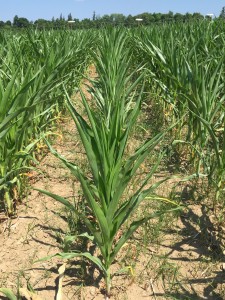 This summer the Tompkins county suffered drought, for almost a month there was no decent rainfall and the water was really deficient for vigorous crop growth. One of our sorghum fields was located in Varna, and it took nearly the whole June for those sorghum seeds to emerge from the soil. The sorghum was usually viewed as a drought-tolerant crop that did not need much water for survival, yet extremely drought after planting would still delay the emergence since seeds could not well germinate without certain amount of moisture.
This summer the Tompkins county suffered drought, for almost a month there was no decent rainfall and the water was really deficient for vigorous crop growth. One of our sorghum fields was located in Varna, and it took nearly the whole June for those sorghum seeds to emerge from the soil. The sorghum was usually viewed as a drought-tolerant crop that did not need much water for survival, yet extremely drought after planting would still delay the emergence since seeds could not well germinate without certain amount of moisture.
 The corn at the Musgrave experimental farm also showed obvious symptom of water deficiency. By the early July, the corn had reached the V8 to V9 stage and the average height was around. Due to the drought, newly-developed leaves rowed and older leaves turned yellowish. Rolling leaves could reduce transpiration of water from the leaf surface, yet it also reduced the solar radiation intercepted by the canopy for photosynthesis. Less photosynthesis would result in insufficient accumulation of biomass. Besides, limited moisture in soil would restrict the roots’ absorption of nutrients. Hence the corn yield might be lower than normal years.
The corn at the Musgrave experimental farm also showed obvious symptom of water deficiency. By the early July, the corn had reached the V8 to V9 stage and the average height was around. Due to the drought, newly-developed leaves rowed and older leaves turned yellowish. Rolling leaves could reduce transpiration of water from the leaf surface, yet it also reduced the solar radiation intercepted by the canopy for photosynthesis. Less photosynthesis would result in insufficient accumulation of biomass. Besides, limited moisture in soil would restrict the roots’ absorption of nutrients. Hence the corn yield might be lower than normal years.
Since the water is usually abundant in New York state during the growing season, not much attention would be paid to irrigation issues, especially in corn and hey production. To increase the crop’s resistance to drought, adjusting planting date and improving soil health are two important methods. By adapting reduced-tillage, leaving more residues on the soil surface or planting cover crops, the soil’s water holding capacity can be increased and thus benefits crops during drought.
I hope there would be more rainfall in the following days. Hang in there, my sorghum seedlings !
